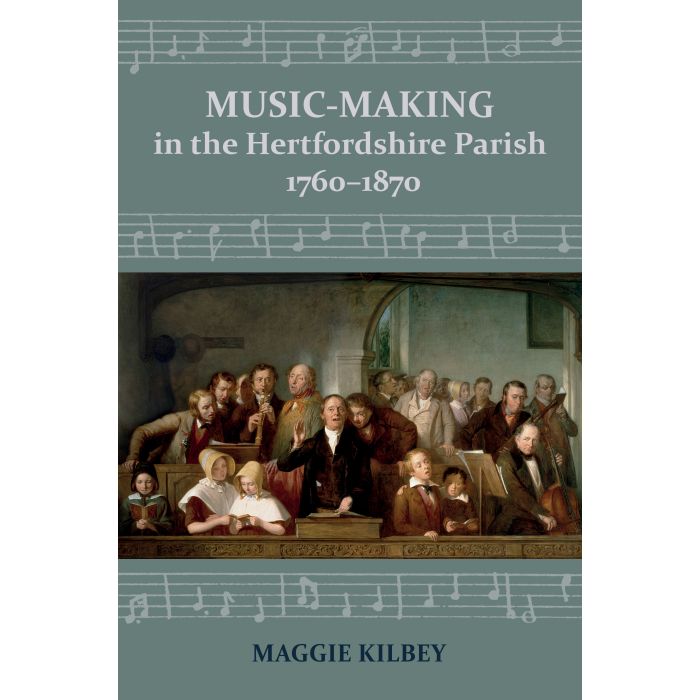Music-making in the Hertfordshire Parish, 1760-1870
Maggie Kilbey explores attempts to improve parochial music-making in Hertfordshire between 1760 and 1870.
| Weight | 0.530000 |
|---|---|
| ISBN13/Barcode | 9781912260263 |
| ISBN10 | 1912260263 |
| Author | KILBEY, Maggie |
| Binding | Paperback |
|---|---|
| Date Published | 5th October 2020 |
| Pages | 292 |
| Publisher | University of Hertfordshire Press |
“Highly recommended, this deserves to become a standard reference text. It has an extensive bibliography which indexes both primary and secondary source material, and the text is interspersed throughout with useful tables and thoughtfully chosen illustrations. The University of Hertfordshire Press is also to be congratulated on the quality, layout and production of the book, which is something of a bargain.” Simon Waters, The Galpin Society Journal
“Thank you, Maggie Kilbey! Your book is a pleasure to read and a valuable addition to the study of music in parish churches.” Fenella Bazin, The Local Historian
“Anyone with an interest in music, church social history, the education of singers and instrumentalists – in fact the music business in general, will find this book a mine of fascinating information. I read it from cover to cover with frequent smiles. Thank you, Dr Maggie Kilbey!” Ruth Jeavons, Herts Past & Present
“Though focussing on one small geographical area, it is no mere case study, for its comprehensive approach means that the author can draw conclusions that are valid for England as a whole. It should be a standard text on later 18th and earlier 19th century music making for many years to come. In the last issue of this magazine, I rated Henderson and Jarvis’s They fly forgotten… as six stars out of five; I am truly blessed to be able to do the same for Maggie Kilbey’s Music-making in the Hertfordshire Parish. It is an excellent read and deserves to be on the shelves of anyone interested in the cultural, liturgical, social and musical heritage of England.” David Baker, Organists’ Review
“Maggie Kilbey has assembled a huge amount of information, and provides an extensive bibliography of primary and secondary sources, including parish records, census returns, the BOA and local directories, periodicals and newspapers. It is interesting to see that both Bevington and Flight, who provided many barrel organs for churches in the county, also published collections of printed tunes to go with their instruments. A companion volume covering the next century would be equally fascinating!” Richard Hobson, The British Institute of Organ Studies Reporter
“Kilbey’s work is a clear, thoroughly researched and persuasive study of the vital sphere of ‘music-making’ in the parishes of Hertfordshire during this period.” Andrew Poxon, Journal of Ecclesiastical History
The standard of congregational singing in mid-eighteenth-century parish churches was often in a parlous state, a situation viewed with alarm by many influential clergy and social commentators. In this authoritative study, Maggie Kilbey explores attempts to improve parochial music-making over the following century and the factors that played a part in their success or failure.
Using Hertfordshire as a basis, original research by this respected author and historian uses a wide range of documentary evidence to reveal a complicated picture of influence and interaction between the gentry, clergymen and their parishioners.
Her innovative approach to the social history of church music-making sheds light on interactions between militia and church bands, singers, organists, the role of charity school children and the use of barrel organs. Because of its proximity to London, Hertfordshire was particularly attractive to elites with an interest in the capital, and fell under the influence of metropolitan music-making more readily than less accessible parts of England.
The involvement of both fashion-conscious and socially aware gentry was mirrored by those further down the social scale, and formed part of a complex pattern of support for church music-making.
Unsurprisingly, this support was not universal, and often short-lived once initial enthusiasm or funding ran out. Consequently, although many attempts were made to ‘improve’ music-making in parish churches, sooner or later these were considered to be failures, swiftly forgotten — and then tried again.
To make matters worse, church rate disputes hampered efforts to improve or sustain parish music-making during the nineteenth century, resulting in financial hardship for organists and other church musicians. Yet this was followed by an 1850s ‘singing craze’ which led to the formation of many church choirs, alterations to the church fabric, and installation of organs.
This investigation into patterns of parochial music-making will appeal to both those with an interest in the history of music-making, and also those with a general interest in the social history of Hertfordshire.
